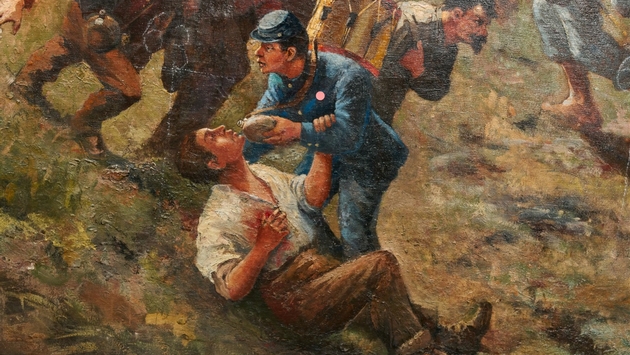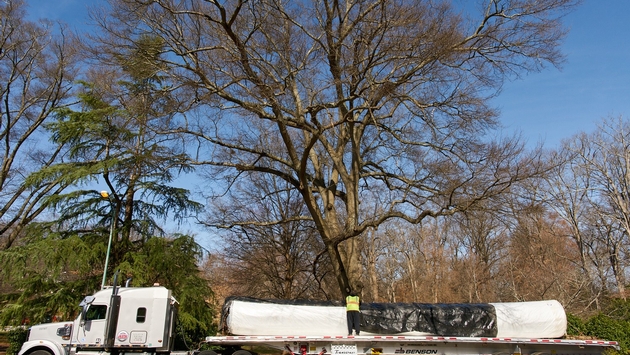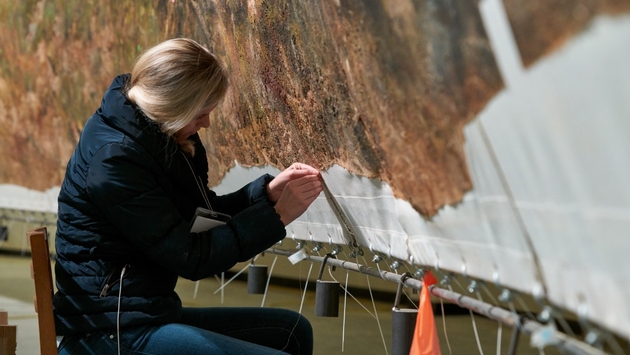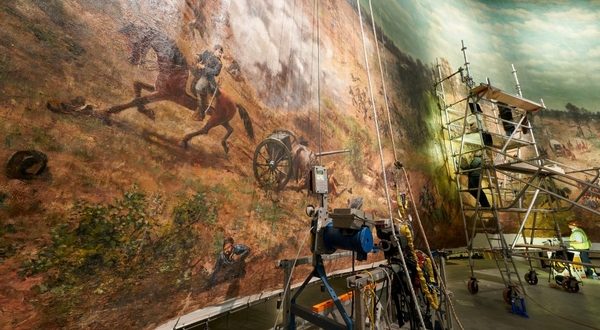[ad_1]
Nostalgia doesn’t exist in Atlanta. The “City Too Busy to Hate” is also the city too busy to hang on to keepsakes.
While you can find “new” around every corner of town—new homes, new shops, new restaurants, new high-rise condos, new hotels, new office buildings—“old” proves elusive.
With nearly 40 percent of Atlanta’s metro population being transplants to the area, few Atlantans have any connection to, or interest in, Georgia’s capital beyond the date when they began calling it home.
And then there was Union Army General William Tecumseh Sherman’s famous burning of the city during the Civil War late in 1864. Atlanta essentially started from scratch after the razing.
All of this comes together in the remarkable story of one relic Atlanta thankfully did hold on to.
Cyclorama: The Big Picture opened February 22 returning to view The Battle of Atlanta after two years of renovation in a new location, the Atlanta History Center. The Battle of Atlanta is a cycloramic painting depicting Union victory during the 1864 engagement.
This, however, is no ordinary war picture.
For starters, cycloramic paintings are enormous and hung circularly for viewing from the inside. How enormous? How about 10,000 pounds. How about 49-feet-tall and longer than a football field.
Enhanced by multimedia storytelling technologies—including a 12-minute, larger-than-life presentation projected onto the painting—the exhibit is housed in the Lloyd and Mary Ann Whitaker Cyclorama Building at the Atlanta History Center, a newly erected, custom-built 25,000-square-foot space.

The Battle of Atlanta cyclorama is one of only two cycloramas in the United States, the other being The Battle of Gettysburg, making the Atlanta History Center home to one of America’s largest historic treasures.
Moving the painting from its previous home of over 120 years in Grant Park to the Atlanta History Center 10 miles north was a feat as gigantic as the painting itself.
“Without doubt, the most difficult part of this whole process was engineering the move of the painting from Grant Park to the Atlanta History Center—that, and constructing an entirely new building designed both as an exhibition space as well as a long-term care facility,” Atlanta History Center Senior Military Historian and cyclorama expert Gordon Jones said.
For transport, the painting had to be cut in two with each half then wrapped around 45-foot-tall spindles. Its condition having deteriorated greatly due to age and neglect, moving The Battle of Atlanta was a nerve-wracking process that involved over 200 people possessing a wealth of specialized knowledge.

Thanks to a full restoration, the cyclorama visitors see now is vastly improved from its later days at Grant Park.
Three missing sections were recreated, adding 2,908-square-feet to the painting, returning it to its original size of 14,952-square-feet. The painting’s sky was restored, replacing a 1922 overpaint added to cover water stains.
A 15-foot stationary platform upon which visitors can view the composition at eye-level was built. A 120-foot, custom-made diorama landscape, including 128 original restored diorama figures from 1936, was added. The entire painting was re-tensioned to correct its hyperbolic shape conveying the originally intended 3D effect.
All of which cost a lot of money.
Fundraising for the project was sparked by a $10 million gift from Atlantans Lloyd and Mary Ann Whitaker with the Atlanta History Center raising $35.78 million for the project, including $10 million for an endowment that will ensure the ongoing care of The Battle of Atlanta and related objects during the 75-year license agreement with the City of Atlanta. Additionally, $2.6 million was dedicated to painting conservation and restoration and $2.9 million to safely relocate the painting.
All of which has paid off with a visitor experience unlike anything else in the nation.
Guests enter the painting rotunda through a tunnel, passing underneath the diorama before ascending an escalator to the 15-foot stationary viewing platform. Here, visitors immediately experience a full 360-degree view of the painting, enhanced by the theatrical presentation projected onto the painting and LED lighting, the likes of which have never shown on the work previously.

Matching the complexity of The Battle of Atlanta’s restoration is its place in Atlanta history. Much like the Civil War itself, the artwork has different interpretations to different members of this one-time Confederate stronghold turned dynamically international and diverse metropolis.
“White Atlanta chose to see it as a memorial to the Confederacy and national reconciliation, Black Atlanta fought for a narrative of freedom while being excluded from Grant Park,” Jones said. “It’s time to talk about that. Let’s bring this artifact into the present and discuss it honestly.”
This cyclorama, while an artifact of the past, still has important lessons to teach contemporary audiences.
“No other object can so vividly tell the story of how attitudes toward the Civil War have been shaped and reshaped over the past 150 years,” Jones said. “In fact, it is the largest single artifact in existence to demonstrate the power of the use and misuse of historical memory.”
[ad_2]You can read more of the news on source
 Travelsmart
Travelsmart



